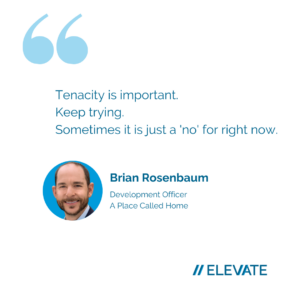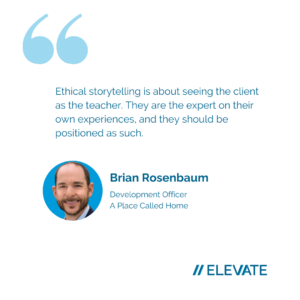Welcome back for a third installment on our Elevate Q&A series, where we “pass the mic” to a member of our extended philanthropic family to examine issues pertinent to the sector and nonprofits! (If you missed our previous conversations, please check out our Q&As with Wade Munday, Bridgestone America’s Director of Corporate Philanthropy; and April Walker, founder of Philanthropy for the People, where we explored some of the challenges and opportunities nonprofits and philanthropists face in pursuing a more equitable approach to their work.)
This time, I spoke with Brian Rosenbaum, the Development Officer for A Place Called Home (APCH), where he holds a portfolio of 150 major and mid-level donors and oversees the organization’s monthly giving program..
For 30 years, A Place Called Home (APCH) has provided South Central Los Angeles youth with a safe, nurturing environment and proven programs in the arts, education, and wellness to help them improve their economic conditions and develop healthy, fulfilling, and purposeful lives. APCH has directly served more than 20,000 youth members through its core school day, after school and summer programming, and over 150,000 local residents through family and supportive services including food, clothing, and holiday toy distributions, counseling, voter education, and community organizing.
Brian is a Southern California native with 18 years of U.S. and international nonprofit experience. He earned his BA in Psychology and Spanish from UCLA and his Masters in Social Work from Columbia University, specializing in program development and community organizing.
My conversation with Brian covered how he leverages his social work training in his current fundraising work, what he sees as the key to successful partnerships with donors, and how he has implemented DEI principles throughout his career.
What It Takes to Successfully Engage Donors
Johnisha Levi: How do you draw upon your background in social work in your current fundraising role?
Brian Rosenbaum: The core values of social work include meeting people where they are, leveraging a strengths-based approach, and capacity building. Each of these is applicable to nonprofit fundraising and communications.
As a nonprofit leader, I also consider ways in which we can hold space for each other to feel seen, to bring our full selves to our work, and to make our best contributions in this world. It’s about discovering ways to pour inspiration into people.
JL: I imagine these values help you to build strong and trusting relationships among colleagues. How would you describe your approach to building relationships with major donors and other partners?
BR: Something that I like to talk about is how “relationship” is sort of a neutral word. You can have a good relationship. You can have a bad relationship. You can have a distant relationship or a close one. On the other hand, a partnership has only one connotation. If you are partners, you are paired.
In a true partnership, everyone gets their needs met, everyone feels heard and seen. And then you grow together and evolve. That’s how I see my role within my staff, with other departments, and with donors; we are partners, and more specifically, we are partners in impact.
When I was at United Way of Greater LA, one of the ways that we described the role of a fundraiser was as a “philanthropic concierge”. It’s all about understanding the impact that a donor wants to make, their priorities, their capacity, their affinity, and their connection to the cause, and then using this information to compose a menu that is in alignment with their passion and interest with our very real funding needs. In implementing this approach, we created meaningful partnerships with donors that led to real impact for our community.
JL: Can you give me an example of your work with a prospective donor that exemplifies this idea of partnering in impact?
 BR: I will share an example of resuscitating a relationship that lapsed prior to my arrival at the Los Angeles Ronald McDonald House. I told my boss, “Challenge accepted.”
BR: I will share an example of resuscitating a relationship that lapsed prior to my arrival at the Los Angeles Ronald McDonald House. I told my boss, “Challenge accepted.”
First, I did a little bit of email outreach to the lapsed donor, and when I didn’t get anything back, I got her on the horn. She was at the grocery store and said she would call back, but she didn’t.
I was tenacious. I got her on the phone again. She shared that she was really disappointed in the lack of appreciation and stewardship. And you know what? Sometimes you just gotta listen. And as a social worker, I embrace any chance I get to listen to people, to really understand what’s going on for them. I told her that I was mortified and angry to hear that she didn’t get the recognition that she deserved. And that she deserved to know the impact of her gift.
I explained how I would do better. I made a list of promises to her, and I delivered on them. Then I brought her in for a tour to see the impact of her gift. At the end of the tour we were sitting down in the dining room having some coffee when she asked about our current needs. I shared a few of our funding priorities, and she said, “Good. Send us a list. You know the things we care about. We’ll see what we can do.”
She and her husband care about safety and security, and comfort and care. So we created a menu with various projects and different price points that were aligned with these interests.
I talked with her several months later. It took some time. But at that point, we settled on a project that satisfied both of our needs – at their previous giving level – and we transformed the broken relationship into a partnership.
Most Important Piece of Advice for a New Fundraiser
JL: You’re clearly a seasoned cultivator and partnership-builder. What advice would you give to a new fundraiser about how to approach donor cultivation?
 BR: I would say, lean into curiosity, be a sponge. Whether you are stewarding or cultivating donors, know those lists of questions to ask donors from a place of authenticity.
BR: I would say, lean into curiosity, be a sponge. Whether you are stewarding or cultivating donors, know those lists of questions to ask donors from a place of authenticity.
One of my favorite questions to ask that people don’t expect is, “How did you become generous?”
It is also crucial to have genuine curiosity about how a donor would like to be engaged. For example, asking, “Can we schedule some time in two weeks to reconnect to see what you thought about this idea?” Or offering, “Can I send you a quarterly update, because you’re part of our impact?” People rarely say no to this last one.
Tenacity is also important: keep trying. We have to respect donors’ wishes but sometimes it is just a ‘no’ for right now.
The Importance of Applying a DEI Lens
JL: Nonprofits and philanthropists are increasingly focused on ensuring that diversity, equity, and inclusion is the lens through which they implement social change. Can you share a little about your own journey with DEI over the course of your career? What are some of the key lessons you’ve learned?
BR: Graduate school really helped me recognize the power and privilege that I bring into rooms and the fact that every white person is on their own journey of unlearning their racism. Biases are in the air that we breathe. You’ve got some sexism in you. You’ve got some heterosexism in you. You’ve got some ableism in you. You’ve got some nativism in you.
It’s like the moving walkway at the airport; you’re just going to be carried to the end unless you start walking the other way. But it takes a lot of self-work.
I committed myself to doing that work when I came back to LA after grad school, starting with getting involved in AWARE-LA (Alliance of White Anti-Racists Everywhere-Los Angeles). They hold both white-only spaces and multi-racial coalition building spaces with the aim of holding each other accountable and in recognition of the fact that people of color should not have to teach white folks about our own racism.
Subsequent to that, and surrounding the events of 2020 following George Floyd’s murder, I was part of an organization that really took advantage of the opportunity to unpack its past. It opened up a giant, very important conversation about some historical trauma that had happened in the organization and that was still affecting staff.
Out of this process came a renewed sense of responsibility, accountability, and personal growth; you don’t get that opportunity very often.
JL: How do you bring these values that have shaped your own thinking about DEI into your partnership building and donor engagement work?
 BR: I am passionate about ethical storytelling. This means presenting our clients as the heroes of their own story, not people who are broken and need to be fixed. We might be experts on suicide prevention, or food insecurity, or homelessness, but the client is the teacher: they are the experts on their experiences, and should be positioned as such. Sometimes I explain this as seeing the two sides of the coin when it comes to a person. Everyone has both strengths and struggles.
BR: I am passionate about ethical storytelling. This means presenting our clients as the heroes of their own story, not people who are broken and need to be fixed. We might be experts on suicide prevention, or food insecurity, or homelessness, but the client is the teacher: they are the experts on their experiences, and should be positioned as such. Sometimes I explain this as seeing the two sides of the coin when it comes to a person. Everyone has both strengths and struggles.
Ethical storytelling is about finding the balance – truthfully representing stories and situations so that we are educating our audiences about the issues that people are facing, while also including the nuances, the complexities, all of the realities of the situation.
Every time we don’t use an ethical storytelling lens, we do damage by reinforcing negative stereotypes. Imagine the negative impact on a client who actually reads that story in the newsletter or in the annual report or on social media!
With that client in mind, I aim to apply a frame of ethical storytelling in my work as a fundraiser.
JL: That is sage advice! What are a few best practices when it comes to ethical storytelling that you employ?
BR: I have the site www.ethicalstorytelling.com bookmarked and use it all the time. For instance, there is a great media consent form that we utilize. It offers individuals the power to consent to share their story or their likeness in a way that is comfortable for them.
It is also important to make determinations about how to use client images and video in a way that is complementary and uplifting, as well as to include clients in the editing process, and to allow them to approve content.
Interested in learning more about ethical storytelling principles? Sign up for our August 2024 webinar, Introducing and Empowerment Framework for Grant Writing, and look for more resources coming your way on this blog!
About the Author:

Grants Specialist & Content Creator










 BR: I will share an example of resuscitating a relationship that lapsed prior to my arrival at the Los Angeles Ronald McDonald House. I told my boss, “Challenge accepted.”
BR: I will share an example of resuscitating a relationship that lapsed prior to my arrival at the Los Angeles Ronald McDonald House. I told my boss, “Challenge accepted.”  BR:
BR:  BR:
BR:





